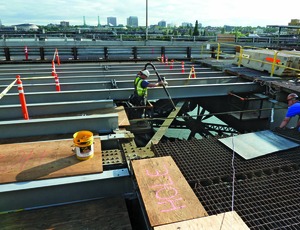
The U.S.'s largest installation of a fiber-reinforced polymer bridge deck can now continue thanks to the resolution of disputes between the contractor and Multnomah County, Ore. Ridgefield, Wash.-based Conway Construction Co. expects to resume its $6.7-million contract in mid-September on the 55-year-old Morrison Bridge after a summer of delays.
The new 17,000-sq-ft, 50-in.-thick deck was to be ready for 33,000 daily vehicles by December, but now completion is unlikely until next year. Over the summer, the county ordered two work stoppages. The owner was dissatisfied with Conway's tarp system, which was designed to shield the Willamette River from construction debris. On Sept. 6, the contractor agreed to build a new containment structure underneath the bridge.
Work first started in June. After new stringers were installed, Conway began adding the fiber-reinforced polymer (FRP) base panels by bolting them to the stringer, says President David Conway. FRP sheets will be fastened on the base panels with 60,000 screws. The top panel will be coated with layers of polymer, a fabric face sheet and a mineral-impregnated polymer finish, he adds.
Ken Huntley, bridge engineer with Multnomah County, says replacing the failing steel bridge deck with the FRP technology increases driving safety by eliminating the slick, slippery steel, saves the river from untreated runoff and provides a long-lasting deck.
After Portland installed a FRP deck, provided by Durham, N.C.-based ZellComp, on the nearby Broadway Bridge in 2010, accidents dropped dramatically, say officials. They decided to do the same with the Morrison Bridge. ZellComp won the competitive bid to design the deck.
“Not only did FRP offer about the same weight as the steel-grating deck, but it also provided a riding surface that was much more like a typical concrete or asphalt deck,” says Huntley. “This would greatly reduce the number of incidents where cars could lose control on a slick steel surface.”
The Broadway Bridge's deck design features voids that drain water that enters the cells. The design also allows for the collection of rainwater for treatment before it is sent back into the river.
ZellComp President Dan Richards says this is the company's eighth installation, which suggests the technology is going mainstream. To ease the learning curve, he says, ZellComp has a two-part system that requires no on-site adhesives or resins and allows contractors to “see the connection system inside the deck.”
Still, the sheer size of the installation— as well as ripping out the old deck and stringers while keeping the six-lane bridge partially open to the traffic exiting Interstate 5 into downtown Portland—will make the project challenging.


Post a comment to this article
Report Abusive Comment